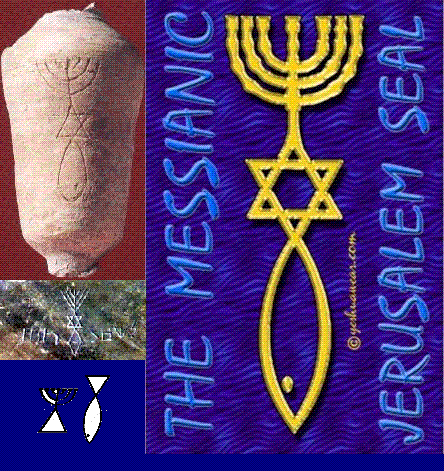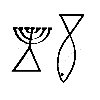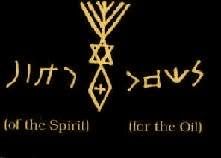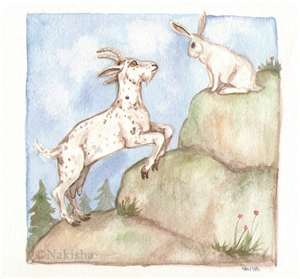Over 40 ancient artifacts were discovered near the traditional site of the Upper Room (of Acts chapters 1 and 2) and the Tomb of David in a cave within the Old City of Jerusalem...
- Ancient History Of The Six-pointed Star and Messianic Seal, by Yahonatan ben-Yahweh (http://all-things-new.net/topic/8143/1)
_________________________________
- Ancient History Of The Six-pointed Star and Messianic Seal, by Yahonatan ben-Yahweh (http://all-things-new.net/topic/8143/1)
_________________________________

_________________________________
...On these artifacts are the 3-part symbol, called the "Messianic Seal". It consists of a menorah at the top, a star of David in the middle, and a fish at the bottom. The star is created within each of the renditions of the three-part symbol by interlacing the menorah stand with the fish's tail.
- Ancient History Of The Six-pointed Star and Messianic Seal
_________________________________

_________________________________
The rather entertaining, black and white pair of ikons, seen slowly moving about just above this text, is commonly known as the 'Messianic Seal' or more properly, as the 'Messianic Seal of Jerusalem'. In essence, this Seal is little more than a very simple, basic three-part insignia consisting of a Seven-Branch Menorah drawn on top of a Christian fish symbol pointing downward, both of which are connected together by a Star of David in the middle. Notice how the triangle-shaped base of the Menorah melds together with the triangular fish tail directly below it to then become a fairly perfect rendition of the Star of David. As one source describes it quite accurately:
Whenever the symbols of the Menorah and the Fish come together as one, the star [of David] is automatically formed in the middle between the two...Likewise, it also is referring to the tri-unity of Abba's divine nature merging downwards from Heaven as one with the tri-unity of man in the earthly realm, who is created in His image and likeness.
- Ancient History Of The Six-pointed Star and Messianic Seal, by Yahonatan ben-Yahweh
_________________________________
Regardless of the Messianic Seal's actual origin (whether it truly is ancient or a modern forgery), it must be said that whoever actually designed this symbol was quite the artistic genius, to say the least. The likelihood of its authenticity continues to be a distinct possibility as a growing number of people continue to believe that this 'Seal' really is, in fact, an ancient symbol of Christianity utilized by some of the first Jewish-Christians in Jerusalem and the surrounding area of Judea.
_________________________________
The rather entertaining, black and white pair of ikons, seen slowly moving about just above this text, is commonly known as the 'Messianic Seal' or more properly, as the 'Messianic Seal of Jerusalem'. In essence, this Seal is little more than a very simple, basic three-part insignia consisting of a Seven-Branch Menorah drawn on top of a Christian fish symbol pointing downward, both of which are connected together by a Star of David in the middle. Notice how the triangle-shaped base of the Menorah melds together with the triangular fish tail directly below it to then become a fairly perfect rendition of the Star of David. As one source describes it quite accurately:
Whenever the symbols of the Menorah and the Fish come together as one, the star [of David] is automatically formed in the middle between the two...Likewise, it also is referring to the tri-unity of Abba's divine nature merging downwards from Heaven as one with the tri-unity of man in the earthly realm, who is created in His image and likeness.
- Ancient History Of The Six-pointed Star and Messianic Seal, by Yahonatan ben-Yahweh
_________________________________
Regardless of the Messianic Seal's actual origin (whether it truly is ancient or a modern forgery), it must be said that whoever actually designed this symbol was quite the artistic genius, to say the least. The likelihood of its authenticity continues to be a distinct possibility as a growing number of people continue to believe that this 'Seal' really is, in fact, an ancient symbol of Christianity utilized by some of the first Jewish-Christians in Jerusalem and the surrounding area of Judea.
_________________________________

_________________________________
As can be seen by the two separate artifacts displayed above, this symbol was found to be marked upon several different items recently discovered in the Old City of Jerusalem. The frequency of its presence upon a fairly large of amount of artifacts indicates that, if genuine, this ikon was most likely held in high esteem by those who originally engraved it in order to mark possibly religious objects such as oil jars and water basins.
Judging by the symbolism alone, those individuals responsible for the symbols are either diabolically clever con-men worthy of world-wide condemnation and punishment, or were, in fact, very real members of the early Christian community.
Now, why would they be Christian in particular? Because there is absolutely no record of any other Jewish sect from that time period who used both a Fish insignia and who also claimed their leader to be a direct descendant of the Royal House of David (symbolized by the Six-pointed Star of David). As one particular source speculates:
According to Bob Fischer (one of the archaeologists who discovered these), at least two of the eight artifacts (SEEN BELOW) were obviously ceremonial pieces which may well have been used by James, the brother of Yahshua, who is alleged to have been the first pastor of the church, or perhaps even by one or more of His twelve apostles.
- Ancient History Of The Six-pointed Star and Messianic Seal
Judging by the symbolism alone, those individuals responsible for the symbols are either diabolically clever con-men worthy of world-wide condemnation and punishment, or were, in fact, very real members of the early Christian community.
Now, why would they be Christian in particular? Because there is absolutely no record of any other Jewish sect from that time period who used both a Fish insignia and who also claimed their leader to be a direct descendant of the Royal House of David (symbolized by the Six-pointed Star of David). As one particular source speculates:
According to Bob Fischer (one of the archaeologists who discovered these), at least two of the eight artifacts (SEEN BELOW) were obviously ceremonial pieces which may well have been used by James, the brother of Yahshua, who is alleged to have been the first pastor of the church, or perhaps even by one or more of His twelve apostles.
- Ancient History Of The Six-pointed Star and Messianic Seal
_________________________________


_________________________________
These eight artifacts shown above were all found to contain the same
3-part Messianic Seal composed of Seven-branched Jewish Menorah atop a Star of David which connects its base to a simple Christian Fish symbol below. As it turns out the traditionally Christian emblem of the Fish may also have even deeper roots within Judaism, apparently because 'the symbol of the Fish has been meaningful to Jews, previous to [Christianity]'.
As of now, all that can truly be said about the Messianic Seal of Jerusalem is there have been many claims, as well as counterclaims, about this particular ikon which continue to pile up in newspapers, magazines, journals and throughout the internet. One could even say the tension still mounts whenever the issue is raised among the experts and scholars actually involved, who apparently continue to vehemently disagree about this mysterious emblem (which seem to have come from out of nowhere). The drama marches on as the shovels keep digging up the dirt throughout today's Israel. Weighing the odds realistically, there is still a chance at least one of those shovels may uncover the real truth concerning the Messianic Seal..
As of now, all that can truly be said about the Messianic Seal of Jerusalem is there have been many claims, as well as counterclaims, about this particular ikon which continue to pile up in newspapers, magazines, journals and throughout the internet. One could even say the tension still mounts whenever the issue is raised among the experts and scholars actually involved, who apparently continue to vehemently disagree about this mysterious emblem (which seem to have come from out of nowhere). The drama marches on as the shovels keep digging up the dirt throughout today's Israel. Weighing the odds realistically, there is still a chance at least one of those shovels may uncover the real truth concerning the Messianic Seal..
_________________________________











